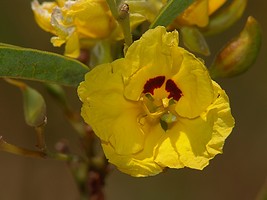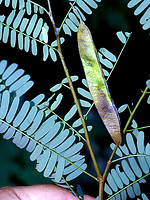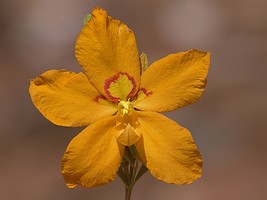Cassieae sensu lato (pro parte)
Martin F. Wojciechowski and Bruce Jones.png?x=-1008249868)


This tree diagram shows the relationships between several groups of organisms.
The root of the current tree connects the organisms featured in this tree to their containing group and the rest of the Tree of Life. The basal branching point in the tree represents the ancestor of the other groups in the tree. This ancestor diversified over time into several descendent subgroups, which are represented as internal nodes and terminal taxa to the right.

You can click on the root to travel down the Tree of Life all the way to the root of all Life, and you can click on the names of descendent subgroups to travel up the Tree of Life all the way to individual species.
For more information on ToL tree formatting, please see Interpreting the Tree or Classification. To learn more about phylogenetic trees, please visit our Phylogenetic Biology pages.
close boxIntroduction
Tribe Cassieae has long been considered an artificial assemblage of unrelated taxa in Caesalpinioideae (Polhill, 1994). In the last formal treatment of this tribe, Irwin and Barneby (1981) divided Cassieae Bronn into five subtribes, Ceratoniinae, Dialiinae, Duparquetiinae, Cassiinae, and Labicheinae (Lewis, 2005). Three of these subtribes, Dialiinae, Duparquetiinae, and Labicheinae, comprise the clade informally referred to here as Cassieae sens. lat. pro parte (Lewis, 2005). The remaining two subtribes are now considered more closely related to other caesalpinioid groups.
Most of the genera in this group (18) are monotypic (with a single species) or very small, with the exception of Labichea Gaudich. ex. DC. (14 species) and (Dialium L. (28 species). They are trees, shrubs, or herbs primarily distributed in forests and woodlands of subtropical and tropical regions around the world (Lewis, 2005). Koompassia excelsa (Becc.) Taub. - at heights of 84-88 m from Sarawak, Malaysia - is regarded as the tallest angiosperm in tropical forests (Mabberley, 1993).
Discussion of Phylogenetic Relationships
Tribe Cassieae, as treated by Irwin and Barneby (1981), is not monophyletic based on analyses of molecular sequence data (e.g., Doyle et al., 1997; Kajita et al., 2001; Herendeen et al., 2003; Wojciechowski et al., 2004). Three of the five subtribes, Dialiinae, Duparquetiinae, and Labicheinae, form a monophyletic group that branches early in the family tree, whereas subtribes Cassiinae and Ceratoniinae are more closely related to other caesalpinioid groups (Cassiinae, with Cassia, Chamaecrista, and Senna as “Cassieae sens. strict.”, in the clade referred to as Caesalpinieae s.l. & s.s., Cassieae sensu stricto, and Mimosoideae, and Ceratoniinae, with the single genus Ceratonia, in the Umtiza clade). Within this group, Bruneau et al. (2001) found support for the monophyly of the three subtribes, although Dialiinae is monophyletic only if the Australian subtribe Labicheinae (with two genera, Labichea and Petalostylis R. Br.) is included within it, closely related to Storckeilla Seem. Sampling of species from the genera shown here is still quite incomplete and so it is uncertain whether any of them are monophyletic or not.
References
Bruneau, A., F. Forest, P. S. Herendeen, B. B. Klitgaard, and G. P. Lewis. 2001. Phylogenetic relationships in the Caesalpinioideae (Leguminosae) as inferred from chloroplast trnL intron sequences. Systematic Botany 26: 487-514.
Doyle, J. J., J. L. Doyle, J. A. Ballenger, E. E. Dickson, T. Kajita, and H. Ohashi. 1997. A phylogeny of the chloroplast gene rbcL in the Leguminosae: taxonomic correlations and insights into the evolution of nodulation. American J. Botany 84: 541-554.
Herendeen, P. S., A. Bruneau, and G. P. Lewis. 2003. Phylogenetic relationships in caesalpinioid legumes: a preliminary analysis based on morphological and molecular data. Pages 37-62 in Advances in Legume Systematics, part 10, higher level systematics (B. B. Klitgaard and A. Bruneau, eds.). Royal Botanic Gardens, Kew, UK.
Irwin, H. S., and R. C. Barneby. 1981. Cassieae Bronn. Pages 97-106 in Advances in legume systematics, part 1 (R. M. Polhill and P. H. Raven, eds.). Royal Botanic Gardens, Kew, UK.
Kajita, T., H. Ohashi, Y. Tateishi, C. D. Bailey, and J. J. Doyle. 2001. rbcL and legume phylogeny, with particular reference to Phaseoleae, Millettieae, and allies. Syst. Bot. 26: 515-536.
Lewis, G. P. 2005. Cassieae. Pages 111-125 in Legumes of the World (Lewis, G., B. Schrire, B. MacKinder, and M. Lock, eds.). Royal Botanic Gardens, Kew.
Mabberley, D. J. 1993. The plant-book, a portable dictionary of the higher plants. Cambridge University Press. UK.
Polhill, R. M. 1994. Classification of the Leguminosae. Pages xxxv - xlviii in Phytochemical Dictionary of the Leguminosae (F.A. Bisby, J. Buckingham, and J.B. Harborne, eds.). Chapman and Hall, New York, NY.
Wojciechowski, M. F., M. Lavin, and M. J. Sanderson. 2004. A phylogeny of legumes (Leguminosae) based on analysis of the plastid matK gene resolves many well-supported subclades within the family. American J. Botany 91: 1846-1862.
Title Illustrations

| Scientific Name | Labichea lanceolata Benth. |
|---|---|
| Location | West Australia |
| Specimen Condition | Live Specimen |
| Copyright | © Bernd Krüger |
| Scientific Name | Poeppigia procera Presl |
|---|---|
| Location | Bolivia |
| Specimen Condition | Live Specimen |
| Copyright | © Robin Foster |
| Scientific Name | Petalostylis labicheoides R.Br. |
|---|---|
| Location | West Australia |
| Specimen Condition | Live Specimen |
| Copyright | © Bernd Krüger |
About This Page
Martin F. Wojciechowski

Arizona State University, Tempe, Arizona, USA
Bruce Jones

Arizona State University
Correspondence regarding this page should be directed to Martin F. Wojciechowski at and Bruce Jones at
Page copyright © 2006 Martin F. Wojciechowski and
All Rights Reserved.
- First online 12 July 2006
- Content changed 12 July 2006
Citing this page:
Wojciechowski, Martin F. and Bruce Jones. 2006. Cassieae sensu lato (pro parte). Version 12 July 2006 (under construction). http://tolweb.org/Cassieae_sensu_lato_%28pro_parte%29/60237/2006.07.12 in The Tree of Life Web Project, http://tolweb.org/











 Go to quick links
Go to quick search
Go to navigation for this section of the ToL site
Go to detailed links for the ToL site
Go to quick links
Go to quick search
Go to navigation for this section of the ToL site
Go to detailed links for the ToL site